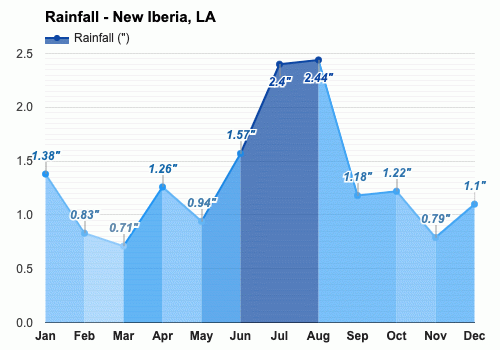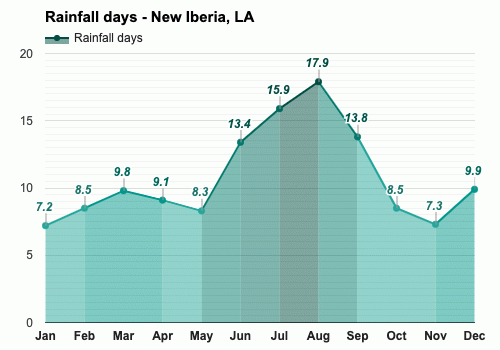Contents
- The climate of New Iberia
- The best time to visit New Iberia
- The worst time to visit New Iberia
- Spring weather in New Iberia
- Summer weather in New Iberia
- Autumn weather in New Iberia
- Winter weather in New Iberia
- Weather in January
- Weather in February
- Weather in March
- Weather in April
- Weather in May
- Weather in June
- Weather in July
- Weather in August
- Weather in September
- Weather in October
- Weather in November
- Weather in December
- Frequently asked questions
- Average temperature
- Average pressure
- Average wind speed
- Average humidity
- Average rainfall
- Average rainfall days
- Average snowfall days
- Average daylight
- Average sunshine
- Average sunshine days
- Average UV index
- Average cloud cover
- Average visibility
Climate and monthly weather forecast
The climate of New Iberia
The annual temperature demonstrates great variety, fluctuating from a high of 90°F (32.2°C) during August and gradually dipping down towards 59.5°F (15.3°C) in January. The frigid end of the thermometer presents a slight variation from 75.4°F (24.1°C) in August to 44.6°F (7°C) in January. On the moisture front, New Iberia sustains a relative humidity that hovers from 76% to 80% during the course of a year.
New Iberia registers an average of 1.38" (35mm) of precipitation in January, surging to 2.44" (62mm) in August. The number of rainfall days varies between 7.2 days in January to a high of 17.9 days in August. Snowfall is non-existent in this city, further emphasising the subtropical nature.
Given New Iberia's geographical location, sunlight availability and intensity vary within the year. Daylight hours range from 10.2 hours in December and escalate towards 14.1 hours in June. New Iberia basks under 5 to 10.7 hours of sunshine varying through a year. The UV index also shows a considerable change, with a score of 3 in December and as high as 7 from May to August.
The best time to visit New Iberia
Between May and September, the city sees an elevated UV index of 7, corresponding to the most significant daylight hours ranging from 13.7 to 14.1. Equally, these months express the highest average of sunshine per day, with 10.3 to 10.7 hours providing abundant time for outdoor activities and explorations of local scenery.
The worst time to visit New Iberia
Spring weather in New Iberia
Summer weather in New Iberia
Autumn weather in New Iberia
Winter weather in New Iberia
Weather in January
Weather in February
Weather in March
Weather in April
Weather in May
Weather in June
Weather in July
Weather in August
Weather in September
Weather in October
Weather in November
Weather in December
Published by: Weather U.S. | About Us
Data Sources | Weather Forecasting & Climate
Frequently asked questions
What time of the year is the coldest in New Iberia?
How much does it rain in New Iberia?
When does it snow?
When does it snow the most?
How many days does it snow?
What is the most humid month?
When it does not snow?
What is the driest month?
When is Daylight Saving Time (DST)?
What are the months with the highest UV index?
When are the longest days?
What month has the most sunshine?
What is the hottest time of year in New Iberia?
What is the wettest month?
What is the least humid month?
What is the month with the shortest days?
What is the month with the least sunshine?
What is the month with the lowest UV index?

Average temperature
New Iberia, LA
The warmest month (with the highest average high temperature) is August (90°F).
The month with the lowest average high temperature is January (59.5°F).
The month with the highest average low temperature is August (75.4°F).
The coldest month (with the lowest average low temperature) is January (44.6°F).

Average pressure
New Iberia, LA
- Average pressure in January:
30.16"Hg - Average pressure in February:
30.1"Hg - Average pressure in March:
30.07"Hg - Average pressure in April:
29.98"Hg - Average pressure in May:
29.98"Hg - Average pressure in June:
29.95"Hg
- Average pressure in July:
29.99"Hg - Average pressure in August:
29.96"Hg - Average pressure in September:
29.96"Hg - Average pressure in October:
30.01"Hg - Average pressure in November:
30.11"Hg - Average pressure in December:
30.11"Hg
The month with the highest atmospheric pressure is January (30.16"Hg).
The month with the lowest atmospheric pressure is June (29.95"Hg).

Average wind speed
New Iberia, LA
- Average wind speed in January:
8.1mph - Average wind speed in February:
8.5mph - Average wind speed in March:
8.1mph - Average wind speed in April:
8.4mph - Average wind speed in May:
7.3mph - Average wind speed in June:
6.2mph
- Average wind speed in July:
5.5mph - Average wind speed in August:
5.5mph - Average wind speed in September:
5.5mph - Average wind speed in October:
6.7mph - Average wind speed in November:
7.5mph - Average wind speed in December:
8.1mph
The windiest month (with the highest average wind speed) is February (8.5mph).
The calmest months (with the lowest average wind speed) are July, August and September (5.5mph).

Average humidity
New Iberia, LA
The month with the highest relative humidity is February (80%).
The month with the lowest relative humidity is October (73%).

Average rainfall
New Iberia, LA
- Average rainfall in January:
1.38" - Average rainfall in February:
0.83" - Average rainfall in March:
0.71" - Average rainfall in April:
1.26" - Average rainfall in May:
0.94" - Average rainfall in June:
1.57"
The wettest month (with the highest rainfall) is August (2.44").
The driest month (with the least rainfall) is March (0.71").

Average rainfall days
New Iberia, LA
- Average rainfall days in January:
7.2 days - Average rainfall days in February:
8.5 days - Average rainfall days in March:
9.8 days - Average rainfall days in April:
9.1 days - Average rainfall days in May:
8.3 days - Average rainfall days in June:
13.4 days
- Average rainfall days in July:
15.9 days - Average rainfall days in August:
17.9 days - Average rainfall days in September:
13.8 days - Average rainfall days in October:
8.5 days - Average rainfall days in November:
7.3 days - Average rainfall days in December:
9.9 days
The month with the highest number of rainy days is August (17.9 days).
The month with the least rainy days is January (7.2 days).

Average snowfall days
New Iberia, LA
- Average snowfall days in January:
0.2 days - Average snowfall days in February:
0 days - Average snowfall days in March:
0 days - Average snowfall days in April:
0 days - Average snowfall days in May:
0 days - Average snowfall days in June:
0 days
- Average snowfall days in July:
0 days - Average snowfall days in August:
0 days - Average snowfall days in September:
0 days - Average snowfall days in October:
0 days - Average snowfall days in November:
0 days - Average snowfall days in December:
0 days
The month with the highest number of snowfall days is January (0.2 days).
The months with the least snowfall days are February, March, April, May, June, July, August, September, October, November and December (0 days).

Average daylight / Average sunshine
New Iberia, LA
- Average daylight in January:
10h and 3min - Average daylight in February:
11h and 1min - Average daylight in March:
12h and 0min - Average daylight in April:
12h and 5min - Average daylight in May:
13h and 4min - Average daylight in June:
14h and 0min
- Average daylight in July:
13h and 5min - Average daylight in August:
13h and 1min - Average daylight in September:
12h and 2min - Average daylight in October:
11h and 2min - Average daylight in November:
10h and 4min - Average daylight in December:
10h and 2min
The month with the longest days is June (Average daylight: 14h and 0min).
The month with the shortest days is December (Average daylight: 10h and 18min).
- Average sunshine in January:
5h and 2min - Average sunshine in February:
5h and 2min - Average sunshine in March:
7h and 2min - Average sunshine in April:
9h and 3min - Average sunshine in May:
10h and 2min - Average sunshine in June:
10h and 4min
- Average sunshine in July:
10h and 2min - Average sunshine in August:
10h and 1min - Average sunshine in September:
10h and 0min - Average sunshine in October:
6h and 4min - Average sunshine in November:
6h and 0min - Average sunshine in December:
5h and 0min
The month with the most sunshine is June (Average sunshine: 10h and 42min).
The month with the least sunshine is December (Average sunshine: 5h and 0min).

Average sunshine days
New Iberia, LA
- Average sunshine days in January:
21.5 days - Average sunshine days in February:
17.3 days - Average sunshine days in March:
19.1 days - Average sunshine days in April:
19.1 days - Average sunshine days in May:
20.1 days - Average sunshine days in June:
14.1 days
- Average sunshine days in July:
12.2 days - Average sunshine days in August:
10.5 days - Average sunshine days in September:
14.3 days - Average sunshine days in October:
21.2 days - Average sunshine days in November:
21.2 days - Average sunshine days in December:
18.5 days
The month with the most sunshine days is January (21.5 days).
The month with the least sunshine days is August (10.5 days).

Average UV index
New Iberia, LA
The months with the highest UV index are May, June, July and August (UV index 7).
The month with the lowest UV index is December (UV index 3).

Average cloud cover
New Iberia, LA
The month with the most cloud cover is December (Cloud cover 47).
The month with the least cloud cover is October (Cloud cover 25).

Average visibility
New Iberia, LA
The months with the highest visibility are January, February, March, April, May, June, July, August, September, October, November and December (6mi).
The months with the lowest visibility are January, February, March, April, May, June, July, August, September, October, November and December (6mi).